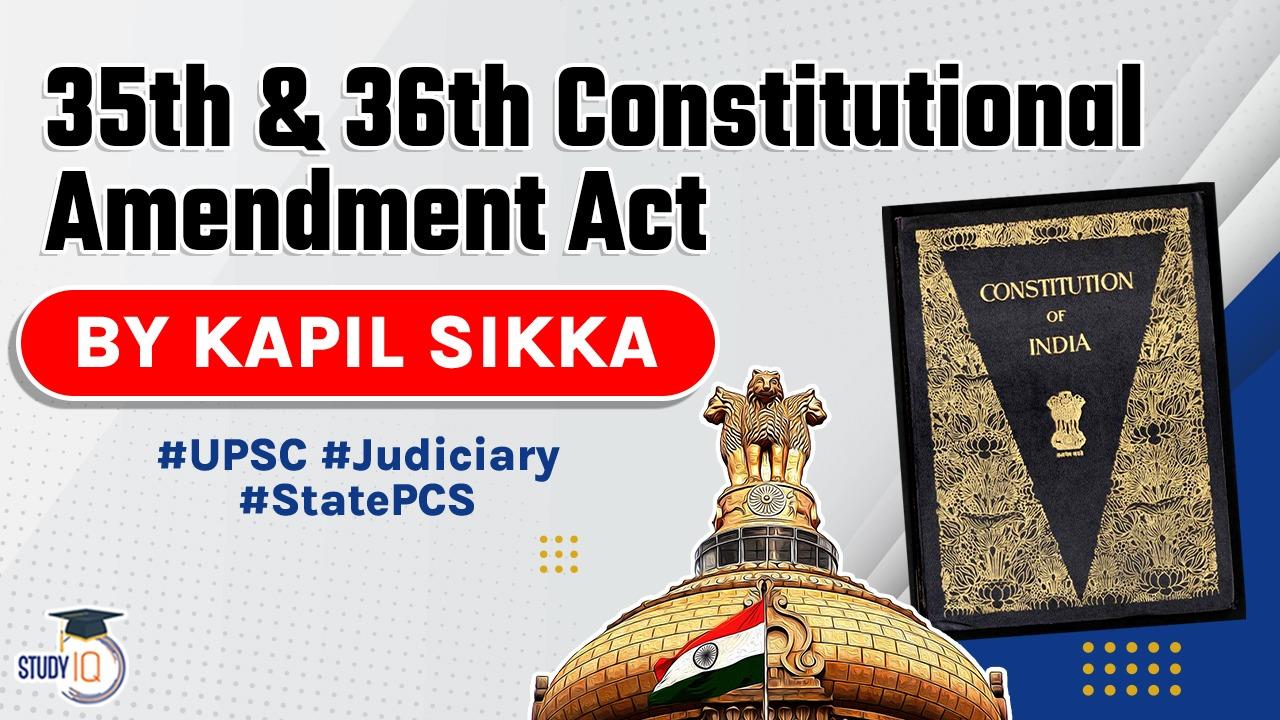Table of Contents
Constitutional Amendments Series
35th Amendment 1974 & 36th Amendment 1975
STATEMENT OF OBJECTS AND REASONS

- In pursuance of the historic agreement of the 8th May, 1973, between the Chogyal, the leaders of the political parties representing the people of Sikkim and the Government of India and of the unanimous desire of the members of the Sikkim Assembly expressed in the meetings of the Assembly held on the 11th May, 1974,
- for the progressive realisation of a fully responsible Government in Sikkim and for furthering its close relationship with India, the Sikkim Assembly considered and passed the Government of Sikkim Bill, 1974 unanimously.
- The Chogyal promulgated this Bill on the 4th July, 1974 as the Government of Sikkim Act, 1974.
- For the speedy development of Sikkim in the social, economic and political fields, section 30 of the Government of Sikkim Act, 1974 empowers the Government of Sikkim, inter alia, to seek participation and representation for the people of Sikkim in the political institutions of India.
- After the promulgation of the Government of Sikkim Act, the Chief Minister of Sikkim had made formal requests to the Government of India through the Chief Executive requesting the Government of India to take such steps as may be legally or constitutionally necessary to give effect to the Government of Sikkim Act, 1974 and the resolutions passed by the Assembly and particularly for providing for representation for the people of Sikkim in Parliament.
- With a view of giving effect to the wishes of the people of Sikkim for strengthening Indo-Sikkim co-operation and inter-relationship, the Bill seeks to amend the Constitution to provide for the terms and conditions of association to Sikkim with the Union.
- The terms and conditions are set out in the Tenth Schedule proposed to be added to the Constitution by clause 5 of the Bill.
- Apart from referring to the responsibilities of the Government of India and the powers of the President in this regard, the Schedule provides for allotment to Sikkim of one seat in the Council of States and one seat in the House of the People and for the election of the representatives of Sikkim in
- the Council of States and the House of the People by the members of the Sikkim Assembly.
Sikkim to be associated with the Union.-
Integration with Union
Sikkim under the Chogyal rulers
- For 333 years before 1975, Sikkim was ruled by the Chogyals (or kings) of the Namgyal dynasty of Tibetan descent.
- According to one account, the first ruler, Penchu Namgyal, was installed as king by Tibetan lamas in 1642.
- At its zenith, the Sikkim kingdom included the Chumbi valley and Darjeeling. The former is part of China now. After 1706, there were a series of conflicts between the powers of the region, which included Sikkim, Nepal, Bhutan, and Tibet, resulting in a shrinking of Sikkim’s territorial boundaries.
- In 1814, Sikkim allied with the East India Company in the latter’s campaign against Nepal.
- After the Company won, it restored to Sikkim some of the territories that Nepal had wrested from it in 1780. In 1841, the Company purchased Darjeeling from the Namgyal rulers.
- A treaty in 1861 made Sikkim a de facto protectorate of British India.
- Subsequently, the Calcutta Convention of 1890 demarcated the border between Sikkim and Tibet, and was signed by Viceroy Lord Lansdowne and Qing China’s Imperial Associate Resident in Tibet. The Lhasa Convention of 1904 affirmed the Calcutta Convention.
- After India became independent in 1947, the relationship between New Delhi and Gangtok had to be redefined. In 1950, a treaty was signed between Maharaja Tashi Namgyal and India’s then Political Officer in Sikkim Harishwar Dayal.
- The relationship between India and Sikkim was encapsulated in the clause: “Sikkim shall continue to be a Protectorate of India and, subject to the provisions of this Treaty, shall enjoy autonomy in regard to its internal affairs.”
- In the following decades, gaping income inequality and feudal control over key resources led to popular discontent against the Chogyal rulers. In December 1947, diverse political groupings came together to form the Sikkim State Congress.
- In 1949, the Chogyal agreed to appoint a five-member Council of Ministers, with three Congress nominees, and two of his own.
- In 1953, the Chogyal introduced a new Constitution, and four general elections were held based on separate electorates in 1957, 1960, 1967, and 1970. Plagued by distrust between the Chogyal and the Congress, none of these elections helped further democracy.
- Matters came to a head in 1973, when the royal palace was besieged by thousands of protesters.
- The Chogyal was left with no choice but to ask India to send troops for his assistance.
- Finally, a tripartite agreement was signed in the same year between the Chogyal, the Indian government, and three major political parties, so that major political reforms could be introduced.
- In 1974, elections were held, in which the Congress led by Kazi Lhendup Dorji emerged victorious over pro-independence parties. In the same year, a new constitution was adopted, which restricted the role of the Chogyal to a titular post.
- The Chogyal resented this, and refused to deliver the customary address to the elected Assembly.
- In the same year, India upgraded Sikkim’s status from protectorate to “associated state”, allotting to it one seat each in the Lok Sabha and Rajya Sabha.
- The Chogyal was unhappy with this move, and sought to internationalise the issue. This did not go down well with Sikkim’s elected leaders, and a referendum was held in 1975.
- A total 59,637 voted in favour of abolishing the monarchy and joining India, with only 1,496 voting against.
- Subsequently, India’s Parliament approved an amendment to make Sikkim a full state.
Constitutional Amendment Series Download Free PDF






















 WhatsApp
WhatsApp